UNROLLING PAGES OF INDIAN HISTORY: MY SOJOURN AT ROYAL RAJASTHAN BY BANI DAYAL DHIR
Dr. Bani Dayal Dhir is an Assistant Professor, at Department Of English Studies
Dayalbagh Educational Institute, Agra India.
|
Next Column:......................................................................................................................................Back
to Columns Index
Finally arrived the much awaited day! The eagerly awaited socio-cultural-spiritual tour for which I waited, I dreamed and I longed the whole year! An ethereal moment, when away from the stress and stir, fret and fever, rush and roar, burden of the work, I perceive the varied beauteous forms of nature in this world.
It was the early summer morning of 2nd June 2013; we offered our prayers and headed to a different terrain- the very beautiful Rajasthan. On my way I was thinking how blessed I was to be with Prof. P.S. Satsangi, my Grandfather, my grandmother Mrs. Satya Satsangi, who always elevate me enliven me and enlighten me.
It was my first visit to Rajasthan. Who has not heard about the royal state of Rajasthan, its vast spread of sand dunes, majestic forts, breath taking frescoes, humble denizens! But I would say my experience in this colourful corner of the world surpassed all descriptions about this state.
We reached Jodhpur on 3rd June, also known as the Sun City, which is the oldest and the second largest city of Rajasthan with bare landscapes of Thar desert, bright and sunny weather though extremely hot in summers. It was founded in 1459 by Rao Jodha of the Rathore clan previously known as Marwah. Jodhpur is also known for its good educational institutions. It was amazing to see the huge trees and wonderful gardens in the middle of Rajasthan. To be honest it was beyond my imagination to see such natural green colours all around.
It was exhilarating to see the beautiful Bal Samand Lake Palace which is a beautiful heritage property but earlier it used to be the summer residence of the royal family of Jodhpur. It is a sprawling property located on a manmade lake. Today this enchanting palace has been converted into a heritage hotel that attempts to revive its past glory. The property is remarkable for its vast expansive lawns, gardens and orchards, the flora and fauna .One comes across nonchalant chirping, hopping and dancing birds and peacocks in the garden -a rare site in today's urbanised world.
Bal Samand Lake Palace
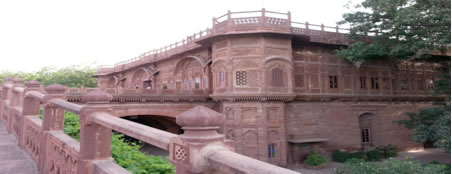

From the serene lake I was taken to Mehrangarh fort again, unrolling pages of Indian history. Mehrangarh fort located in Jodhpur is one of the largest forts in India. The fort is situated 400 feet above the city and is enclosed by imposing thick walls. There are seven gates which include Jayapol (meaning victory), built by Maharaja Man Singh to commemorate his victories over Jaipur and Bikaner armies. Fattehpol (also meaning victory) gate was built by Maharaja Ajit Singh to mark the defeat of the Mughals. The museum in Mehrangarh fort is one of the most well-stocked museums in Rajasthan. In one section of the fort museum there is a selection of old royal palanquins. The museum exhibits the heritage of the Rathores in arms, costumes, paintings and decorated period rooms. Many perhaps also don't know that the third movie of the Dark Knight trilogy, The Dark Knight Rises was partially shot around the Mehrangarh Fort.

Mehrangarh Fort

Sea of blue houses in the blue city Jodhpur from Mehrangarh fort: The Blue Magic
At Mehrangarh fort the visitors have the option of going up to the highest level by elevator or doing both the ascent and descent on foot. We took the elevator and reached the highest level of the fort, and it is from Mehrangarh fort that we come to know why Jodhpur is also the "Blue City." We saw a sea of blue houses from the top; these houses are integral part of Jodhpur .The walls in the oldest part of the city near the fort are often painted blue and because of the vivid blue painted houses around the fort, Jodhpur is also known as the "Blue City."
Our next stop was the Umaid Bhawan Palace. Umaid Bhawan Palace, is one of the world's largest private residences. A part of the palace is managed by Taj Hotels now. It is named after Maharaja Umaid Singh, grandfather of the present owners of the palace, this monument has 347 rooms and serves as the principal residence of the erstwhile Jodhpur royal family. The present owner of the palace is Maharaja of Jodhpur Gaj Singh.

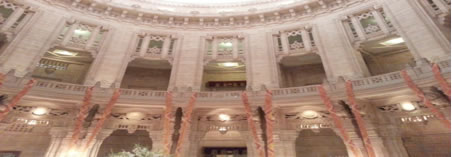
Majestic Umaid Bhawan Palace
The cerulean landscapes of Jodhpur, the astounding gardens and amazing historical monuments still linger in mind, as I often I turn to them in hours of solitude.
Our next destination was Udaipur, the City of Lakes. It is located 403 kilometres southwest of the state capital, Jaipur. Apart from its history, culture, and scenic locations, it is known for its Rajput-era palaces. Lake Pichola, Fateh Sagar lake, Udai Sagar and Swaroop Sagar in this city are some of the most beautiful lakes in the state. Carrying impressions of the extraordinary scenic landscape, lush green lawns and water views we reached Udaipur. Because of its picturesque and scenic locations, Udaipur has been the shooting location for many Hollywood and Indian movies.
On reaching Saheliyon-ki-Bari, a beautiful garden and a popular tourist place, I became nostalgic. Memories of my visit to this place almost 2 decades ago with my grandparents reeled before my eyes. I almost relived those lovely moments for some time-- how dressed in bright Rajasthani outfit, holding the hands of my grandparents, with childhood wonder and admiration for the beautiful place, l had gone around the place. The sight of marble elephants again pushed my thoughts down the memory lane that how my grandfather affectionately and lovingly had made me sit on the marble elephant. I remembered to my utmost joy that this unforgettable moment was captured in camera and I still have that 'never to be lost' photograph with me. I unknowingly experienced the same childhood urge, wanting to hold their hands and run all around swaying my multi-coloured Rajasthani lehenga! Overwhelmed by emotions, I realized how fortunate I was for having this travel experience with my grandparents again.

Unforgettable Saheliyon-ki-Bari
Saheliyon-ki-Bari was built by Maharana Bhopal Singh. As per the legends, the garden was designed by the king himself and he presented this garden to his queen. The queen was accompanied by 48 maids in her marriage. This garden was made to offer them, pleasurable moments away from the political intrigues of the court. It used to be the popular relaxing spot of the royal ladies.
Next day, we went for a morning walk to Fateh Sagar lake. It is said to be the pride of the city of lakes. It is an artificial lake constructed in the north-west of Udaipur. It is one of the four lakes of Udaipur city, the other three lakes are- the lake Pichola, Udai Sagar lake and Dhebar lake or Jaisamand lake.

At the serene Fateh Sagar lake
Pages from Indian history unraveled again as we came to Rajasthan-Haldighati. It is a mountain pass in the Aravalli range of Rajasthan. The name is believed to have come from the turmeric-coloured yellow soil. There is a place called Rakht Talai where the battle of Haldighati was fought between Maharana Pratap and the Mughals. Thousands of soldiers died on both sides and their blood flowed to such an extent that formed a pool. And since then this place has come to be known as Rakht Talai.
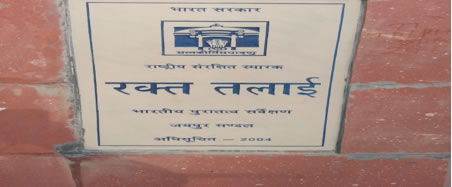
Rakht Talai—(Pool of Blood, in translation)
Remembered as the most important event in Rajput history, the battle of Haldighati was fought between Akbar (Mughal ruler) and Maharana Pratap Singh (ruler of Rajputs). It lasted for only 4 hours. We were told how Maharana Pratap, astride his favourite steed "Chetak" attacked Man Singh and with his spear killed the Mahout, while Man Singh managed to escape. During the encounter, one of Chetak's hind legs was wounded from a sword held in the elephant's trunk. The injured steed "Chetak" ran through the mountains carrying Pratap and finally crossed the stream by jumping over it. There, finding Pratap safe, the royal steed died. It would be difficult to find another such example of an animal's devotion and loyalty to his master. Chetak's sacrifice and his loyalty undoubtedly remind us of a co-existence between human and animals, from which human beings have alienated themselves. The memorial stone and tomb of Chetak still exists, adding glory to this place.
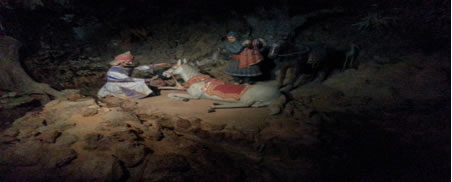
Sacrifice of Horse Chetak for his Master
On the whole Udaipur was captivating, triggered various emotions, and thoughts. Especially significant was a long chat about the places and Haldighati with my grandmother and her delightful anecdotes and stories about them.
With myriad impressions of beautiful gardens, lakes and majestic palaces we moved to our next destination- 'Pink City' i.e. Jaipur. We stayed for two days here. Jaipur is the capital and the largest city of the Indian state of Rajasthan. It was founded by Maharaja Sawai Jai Singh II, the ruler of Amer, after whom city has been named. Jaipur is one of the major tourist destinations in India.


Our first visit was to the City Palace which is situated in the heart of the city. The history of the City Palace is closely linked with the history of the Jaipur city and its rulers. On the day we visited, the sun was bright and the weather was quite hot as it usually is in the month of June but the heat could neither disturb us nor distract us, so captivating was the 'pink walled' palace! Also, a ride in the golf cart with my grandmother is something I will cherish lifelong.


A Sneak Peek Into Grand City Palace
From the City Palace we went to Jantar Mantar which is the collection of architectural astronomical instruments, built by Sawai Jai Singh who was a Mughal commander and served Emperor Aurangzeb and the later Mughals. The title of (King) and Sawai was bestowed on him by Emperor Mohammad Shah. The Jaipur observatory has been inscribed on the World Heritage List as "an expression of the astronomical skills and cosmological concepts of the court of a scholarly prince at the end of the Mughal period." The name is derived from Jantar ("instrument"), and Mantar ("formula", or in this context "calculation"). Therefore, Jantar Mantar means an instrument for calculation.Today the observatory is a popular tourist attraction. There are plenty of observatories all over the world, but the Jantar Mantar of Jaipur is considered to be one of the largest observatories ever built.
Jantar-Mantar

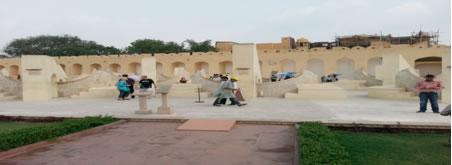
Our excursion through Jantar Mantar was a unique and altogether different experience for me. Though I was quite puzzled initially, as it appeared very scientific, gradually I absorbed things around me as I walked through solid geometry and the ancient collective astronomical system designed to probe the heaven. The highlight of the trip to Jantar Mantar, was also the kind guide who was with us throughout and explained everything very patiently.
With the melodious rendition of 'Ath Prem Sutram'(hymn) playing around us, an essence of spirituality and tranquility seeped through me. I experienced an amazing fusion of science and spirituality and recalled several discussions with my grandfather during the course of my research in Systems theory and literature when I learned about the relevance of Holistic Systems Thinking and how all disciplines are connected to one another. I am beholden to him for not only teaching me but also making me experience this in such a unique way.
Next day our visit was scheduled for Amer Fort, but on our way we quickly caught a glimpse of Hawa Mahal. We were told that Hawa Mahal was built by Maharaja Sawai Pratap Singh, and designed by Lal Chand Ustad in the form of the crown of Krishna, the Hindu God. It is a five storey palace having 953 small windows called Jharokhas that are decorated with intricate latticework. The intention of this work was to allow the royal ladies to observe everyday life in the street below without being seen, since they had to observe strict "purdah". It also provided cool air caused by the effect through the intricate pattern and thereby air conditioning the whole area during high temperatures in summers.
Amer fort is located in Amer 11 kms from Jaipur, Rajasthan. It is one of the principal tourist attractions in the Jaipur area located high on a hill. Amer fort was built by Raja Man Singh I. Here, we saw the Diwan-e-Aam or the "Hall of Public Audience", the Diwan-e-Khas or the "Hall of Private Audience", the Sheesh Mahal and we all saw a very intelligently made Sukh Niwas where a cool climate is created by winds that blow over the water cascade within the palace.
Amer Fort: A Splendorous View


Somehow, the beauty, magnificence and richness of Amer fort which is also called Amber fort still lingers in my mind. I was astonished to see how they had created air-conditioning effect with such limited resources in the olden days. I was also quite thrilled to see Sheesh Mahal where the famous song of the Hindi film "Mughal-e-Azam" was filmed.
During my visit to the majestic palaces I recalled the vivid descriptions of the royal estate Balmer , the royal life and also the protagonist Princess Jaya in Gita Mehta's first novel Raj. Raj holds a very special significance for me as I had selected it for research and applied Systems theory for the first time in the analysis of the novel. Raj is a novel which presents Mehta's extraordinary representation of the historical, political and cultural complexities of India, British and the Royal under the Raj.
While listening to the stories of kings and queens, customs like purdah system, I could draw parallels between what I had read and what I saw here. A Jaipur trip isn't complete without some authentic Rajasthani shopping and I bought some gorgeous Rajasthani outfits, bandhni chunnis and salwar kameez.
Though my narrative of memory stops here, these moments will never efface from my memory. I grew up with stories about varied strands of Indian culture and this trip made me understand history and my roots in a way that I had never envisioned.
Next Column: |

